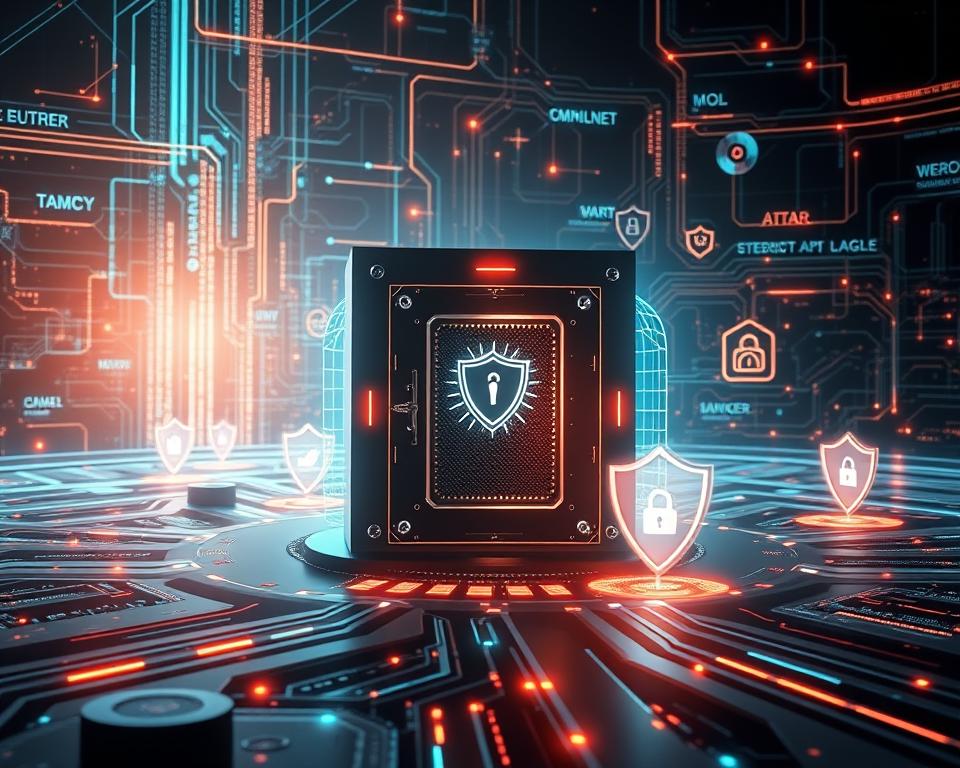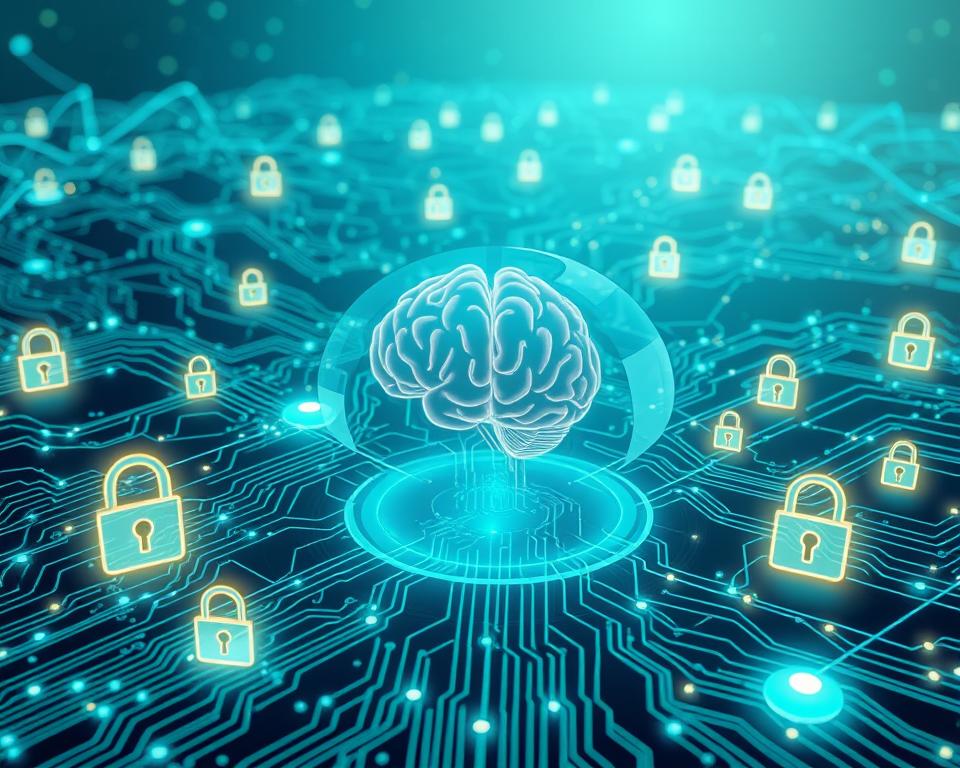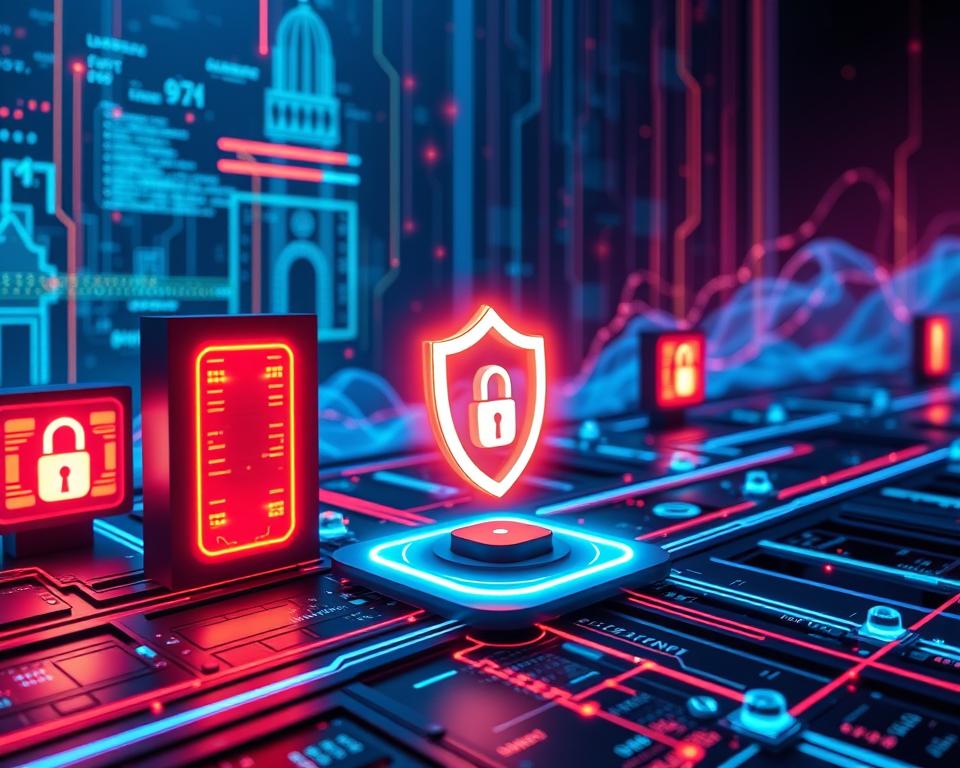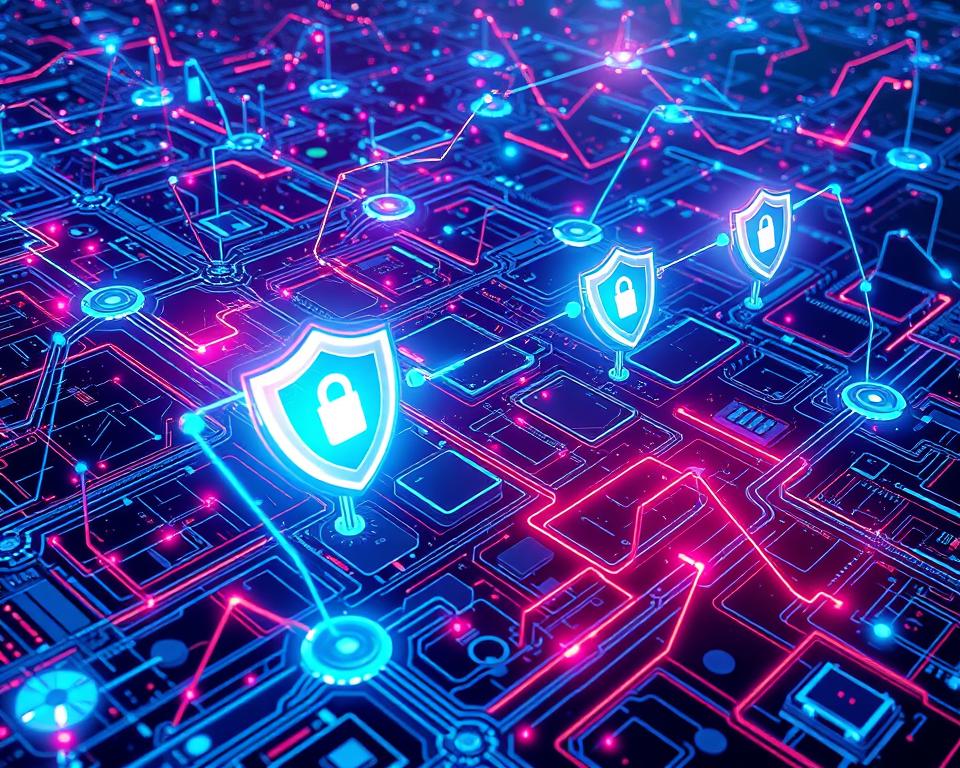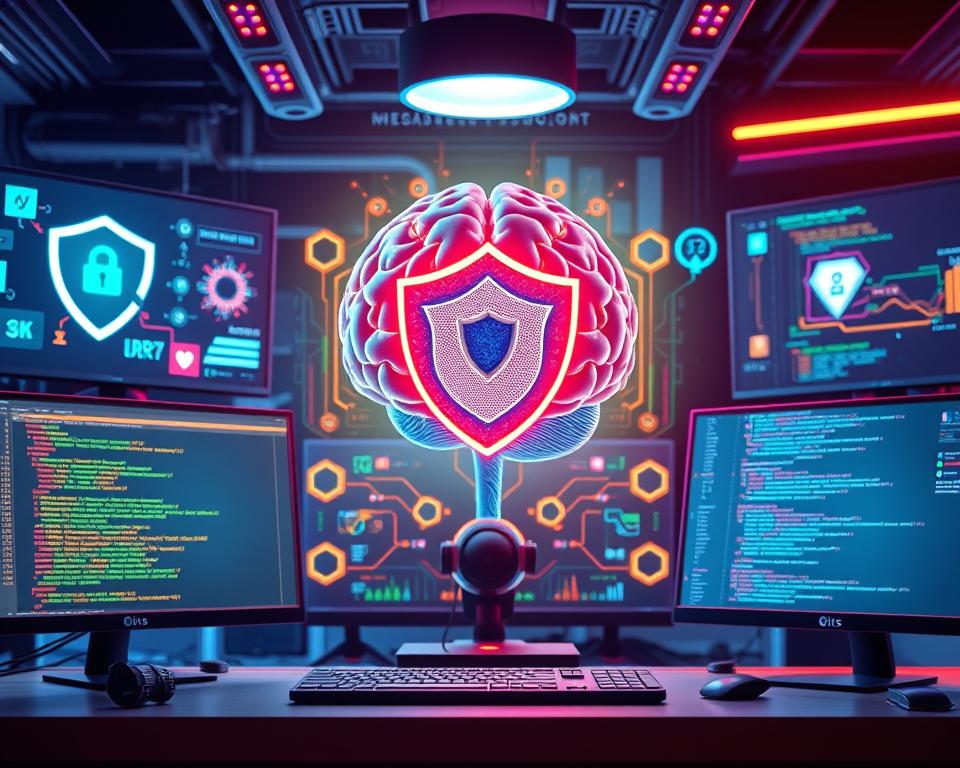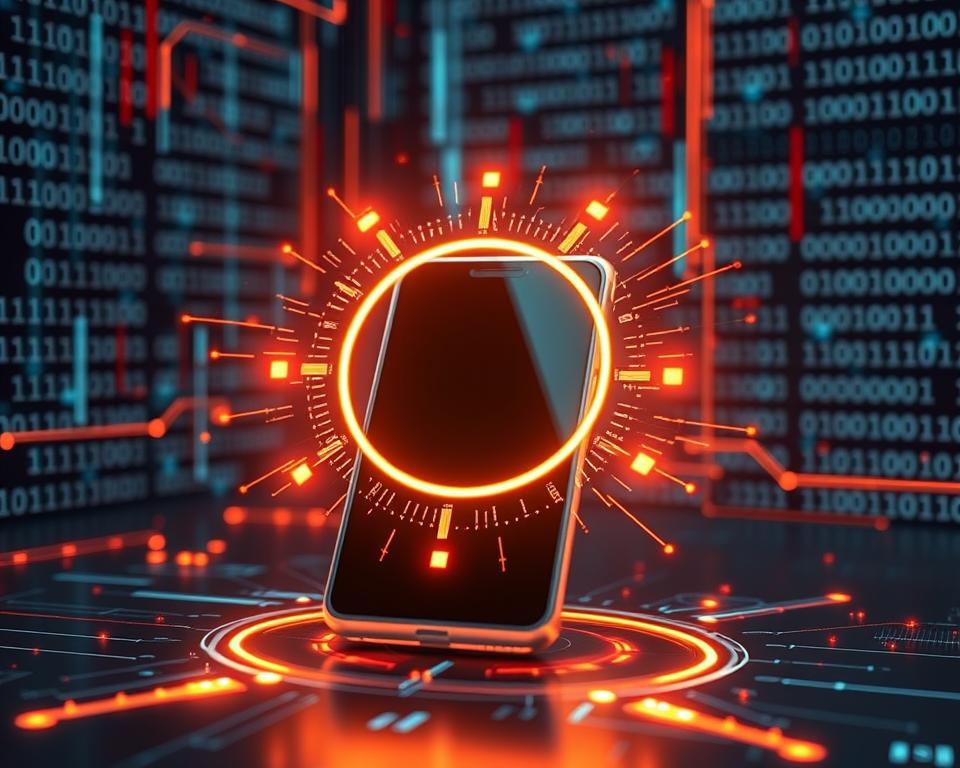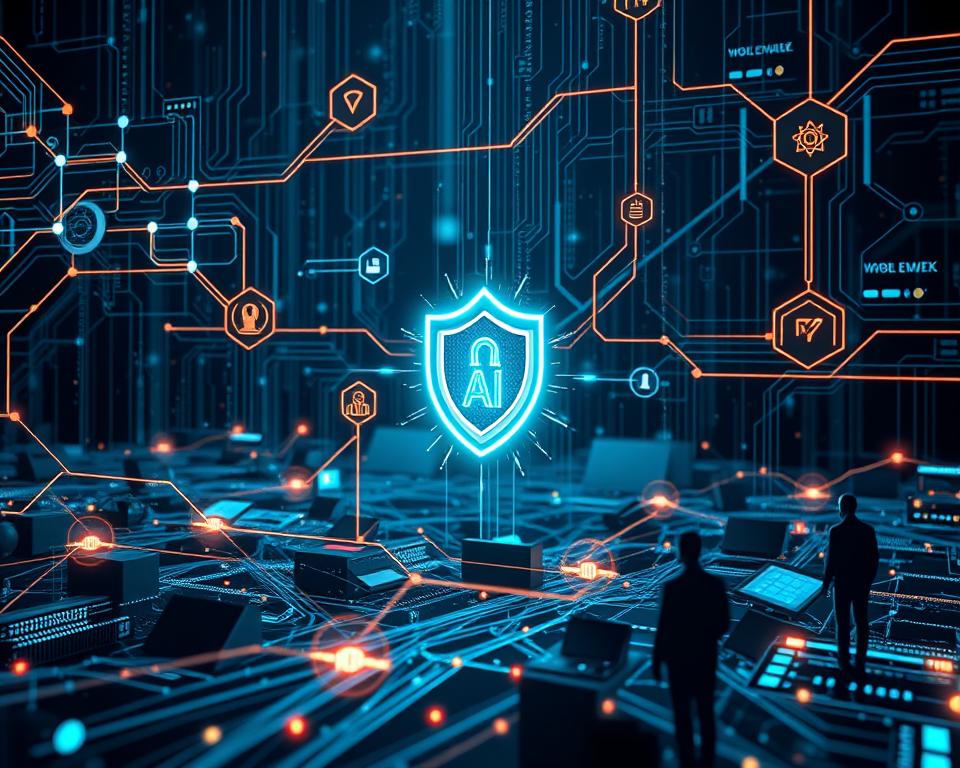AI security is key in web and mobile development as cyber threats grow. Cybersecurity is now using AI to better detect and fight threats. This change means we can be more proactive and flexible in how we handle security.
Old security methods can’t keep up with today’s threats. AI-powered solutions use machine learning to spot and stop risks better than humans. This helps developers make safer web and mobile apps, keeping users safe from cyber dangers.
Cybersecurity with AI can look through lots of data, find patterns, and spot oddities. This makes it better at stopping cyber attacks. AI in cybersecurity is getting more common and is very important. As threats keep changing, AI will be key in keeping web and mobile apps safe.
Table of Contents
Key Takeaways
- AI security is becoming increasingly important in web and mobile development
- Cybersecurity solutions are evolving to include AI-powered technologies
- AI-powered cybersecurity solutions offer a proactive and adaptive approach to threat detection and response
- Machine learning algorithms are used to identify and mitigate risks
- AI-powered cybersecurity solutions can analyze vast amounts of data and detect anomalies
- The use of AI in cybersecurity is becoming more prevalent and critical in protecting web and mobile applications
Understanding AI-Powered Cybersecurity Fundamentals
As technology gets better, we need stronger cybersecurity. AI security leads the way, helping us find and fight threats before they happen. It uses machine learning in security to spot patterns and find dangers.
The way we protect ourselves online has changed a lot. Old methods are being replaced by new, smarter technologies. This change is because cyber threats have gotten more complex, and AI can help fight them.
Definition and Core Components
AI-powered cybersecurity systems learn from what they see, getting better at fighting threats over time. They use machine learning algorithms to look at lots of data and find patterns that might mean trouble.
Evolution of Cybersecurity Technologies
AI and machine learning in security have changed cybersecurity a lot. Old tools like firewalls and antivirus software are still around. But now, they work alongside newer, smarter AI systems.
The Role of Machine Learning in Modern Security
Machine learning in security is key in today’s cybersecurity. It lets systems spot and act on threats right away. This is thanks to algorithms that can look at huge amounts of data, finding patterns and oddities that might mean danger.
Using cybersecurity fundamentals like AI security and machine learning in security is crucial for keeping safe online. Knowing these basics helps us stay ahead of cyber threats. It helps us protect our data and keep our systems safe.
| Technology | Description |
|---|---|
| AI Security | Uses machine learning algorithms to detect and respond to threats |
| Machine Learning in Security | Enables systems to learn from experience and adapt to new threats |
| Cybersecurity Fundamentals | Provides a proactive approach to threat detection and response |
Current Landscape of Cyber Threats in Digital Development
The world of cyber threats is getting more complex. Web and mobile apps have made it easier for hackers to find ways in. Reports show we need strong web development security to fight off common attacks.
In mobile app security, threats are getting smarter. Hackers are finding new ways to steal user data. We must use encryption, secure login, and keep apps updated to fight back.
- SQL injection attacks
- Cross-site scripting (XSS) attacks
- Malware and ransomware attacks
These threats can cause big problems for businesses and people. They can lead to money loss, damage to reputation, and stolen data.
To keep up, we must focus on web development security and mobile app security. We should invest in strong security and keep learning about new threats. This way, we can keep our digital world safe for everyone.
How AI is Transforming Traditional Security Measures
AI in cybersecurity is changing how we handle security. It can look through lots of data to find threats fast. This is key for spotting threats early, before they cause harm.
AI also helps with predictive security. It looks at past data and current info to guess future threats. This lets companies act before attacks happen, not just after.
Pattern Recognition and Threat Detection
AI uses machine learning to spot patterns that might mean trouble. It watches for odd network actions or suspicious logins. This way, AI warns security teams about possible dangers, so they can act fast.
Automated Response Systems
AI also helps with quick responses to threats. These systems can act fast to stop damage or data loss. This means threats are handled quickly, without waiting for people to act.
Predictive Security Analysis
Predictive security is a big part of AI’s role in keeping systems safe. AI looks at past and current data to predict threats. This lets companies stop attacks before they start, not just after.
| Benefits of AI in Cybersecurity | Description |
|---|---|
| Improved Threat Detection | AI-powered systems can detect threats more efficiently and effectively |
| Predictive Security | AI-powered systems can forecast potential threats before they occur |
| Automated Response | AI-powered systems can respond quickly to detected threats, reducing the risk of damage or data loss |
Implementation of AI Security in Web Applications
Web development is always changing, and AI security in web development is more important than ever. It’s key to keep web apps safe from cyber threats and protect user data. This means using AI tools and technologies in the development process to boost web application security.
To implement AI security well, you need to pick the right AI tools. Then, make sure they work with your current security measures. Always keep an eye on your system and update it as needed. Here are some important steps:
- Do a deep risk assessment to find weak spots
- Create a detailed security plan that uses AI tools
- Make sure AI tools fit with your current security setup
- Give your team the training and support they need
By focusing on AI security in web development and following these steps, web developers can make their apps much safer. This helps protect users and stops expensive cyber attacks.
To really make AI security work in web apps, you need a plan that uses the latest tech, tests everything, and keeps checking. By leading in web application security and using the newest AI security tools, developers can make apps that are safe, reliable, and trustworthy. These apps will meet the changing needs of users.
| AI Security Measures | Benefits |
|---|---|
| AI-powered threat detection | Enhanced security and reduced risk of cyber attacks |
| Automated incident response | Faster response times and minimized damage |
| Continuous monitoring and updates | Improved system integrity and reduced downtime |
Mobile Development Security Enhancement Through AI
Mobile app security is crucial today, and AI is key in improving it. With more devices and apps, cyber threats and data breaches are rising. AI tools help detect and prevent threats, protect apps, and innovate user authentication.
AI brings new security features like code analysis and vulnerability detection. These tools check app code for weaknesses, helping developers fix issues early. They also offer real-time protection, keeping apps and data safe.
AI also makes user authentication better and easier. For example, AI-powered biometric authentication uses facial recognition or fingerprints. This method is more secure than passwords and reduces unauthorized access risks.
- Improved mobile app security
- Enhanced user authentication
- Real-time threat detection and prevention
Using AI in mobile development makes apps more secure and reliable. This protects users’ data and fights cyber threats. As mobile use grows, so will the need for better security and AI in app development.
The Rise of AI-Powered Cybersecurity in Web and Mobile Development: Current Trends
Today, AI cybersecurity trends show a big move towards using artificial intelligence and machine learning. This is because cyber threats are getting more complex. We need better ways to defend ourselves.
Some key trends in AI-powered cybersecurity are:
- Cloud-based AI security solutions are becoming popular. They offer more flexibility and scalability.
- AI is being combined with other security tools like intrusion detection systems and firewalls.
- There’s a big push for AI in incident response. This helps lessen the damage from security breaches.
Experts predict a big increase in demand for AI-powered cybersecurity solutions soon. This is because we need better web and mobile security more than ever. As threats keep changing, AI cybersecurity trends will be key in shaping the future of security.
The current AI-powered cybersecurity trends show how important AI and machine learning are for web and mobile security. As the field keeps growing, we’ll see even more creative uses of AI in keeping us safe.
| Trend | Description |
|---|---|
| Cloud-based AI security solutions | Scalable and flexible security solutions hosted in the cloud |
| AI-powered incident response | Automated response systems to reduce the impact of security breaches |
Machine Learning Algorithms in Security Protocol Development
Machine learning is key in making security protocols strong. AI helps spot and stop cyber threats. This keeps web and mobile apps safe. Machine learning looks at patterns to find threats.
Machine learning has changed how we make security protocols. AI lets us make protocols that fit specific needs. This adds extra protection against cyber attacks.
Supervised Learning Applications
Supervised learning finds known threats. It’s trained on labeled data. This lets it spot patterns and threats.
Unsupervised Threat Detection
Unsupervised threat detection finds unknown threats. It’s trained on data without labels. This lets it find oddities and threats.
Deep Learning Integration
Deep learning looks at complex patterns to find threats. It’s trained on big datasets. This lets it spot complex patterns and make good guesses.
- Improved threat detection
- Enhanced security protocols
- Increased efficiency
Real-time Threat Detection and Response Systems
Real-time threat detection is key for good cybersecurity. AI-powered systems can look at lots of data fast. They find threats as they happen and act quickly to lessen damage. This helps companies respond faster and stay safer.
Some examples of AI-powered real-time threat detection systems include:
- Network traffic analysis tools
- Intrusion detection systems
- Endpoint detection and response tools
These systems usemachine learning algorithms to spot patterns and oddities in real-time. This lets them find and handle threats better.
Using real-time threat detection and AI-powered response, companies can get better at handling security issues. This is very important today. Cyber threats are getting faster and more complex all the time.
Integration Challenges and Solutions
Organizations face AI integration challenges when trying to boost their cybersecurity. These issues can include technical problems, managing resources, and compatibility issues.
To tackle these problems, a step-by-step approach is helpful. This method lets organizations slowly add AI-powered solutions to their systems. It helps spot and fix issues early, making the transition smoother. Also, planning how to use resources wisely is key. This ensures the right skills and setup are in place for AI solutions.
Important steps for adding AI-powered cybersecurity solutions include:
- Checking if they work well with current systems
- Training staff to use new tools
- Keeping an eye on how well these solutions work
By tackling these AI integration challenges and using good cybersecurity solutions, companies can improve their defenses. This helps them fight off new cyber threats.
Getting AI-powered cybersecurity to work well needs a detailed plan. Each company has its own set of challenges. By planning carefully and taking it one step at a time, companies can overcome these hurdles. This way, they can enjoy the benefits of better cybersecurity.
Best Practices for AI Security Implementation
Putting AI security into action needs following the best ways to do it. This makes sure AI helps keep things safe without making things worse. Continuous monitoring and regular updates are key to keeping AI security systems strong. It’s also important to follow comprehensive testing to find and fix any weak spots.
AI security best practices cover many areas. They include making sure AI works well with current security systems. This means continuous training of AI models to keep up with new threats. It also means working together with experts to use their knowledge.
- Doing detailed risk assessments to spot possible weaknesses
- Creating and using incident response plans to handle security breaches
- Setting up clear communication channels for teamwork and sharing info
By sticking to these AI security best practices and guidelines, companies can make sure AI security works well. This boosts their safety and lowers the chance of cyber attacks.
Cost-Benefit Analysis of AI Security Solutions
Businesses must weigh the costs and benefits when considering AI security solutions. The upfront cost can be high, but the long-term gains are often greater. AI security cost-benefit analysis is key to seeing if these solutions are worth it.
Important factors in this analysis include:
- Initial investment costs, such as hardware and software expenses
- Ongoing maintenance and updating costs to keep the system effective
- Long-term ROI projections, including potential cost savings and revenue increases
Financial reports show AI security can lead to big returns. By doing a detailed cost-benefit analysis, companies can make smart choices. This ensures they get the most out of their ROI projections.
Finding the right balance between cost and benefit is crucial for AI security success. By carefully looking at the AI security cost-benefit and ROI projections, businesses can invest wisely. This sets them up for long-term success.
Future Prospects and Emerging Technologies
The future of AI security looks bright with new technologies on the horizon. These advancements will change how we protect AI systems, bringing both benefits and challenges. Quantum computing, edge computing, and next-generation AI are leading this change.
Quantum computing could make AI security faster and more powerful. It might help solve complex problems in cryptography and threat detection. Edge computing, meanwhile, will make AI systems work better in real-time. Next-generation AI will learn and adapt in new ways, making security even stronger.
Key Emerging Technologies
- Quantum Computing: Enhancing cryptographic techniques and complex calculations.
- Edge Computing: Improving real-time data processing for more efficient security responses.
- Next-Generation AI Applications: Advanced learning and adaptation capabilities for enhanced security.
These new technologies will shape the future of AI security. It’s vital for companies to keep up with these advancements. This way, they can use these technologies to improve security and stay ahead in the market.
Regulatory Compliance and AI Security
It’s vital for companies to follow AI security rules to avoid legal and financial issues. The rules for AI security are complex, with many laws and standards. These include the General Data Protection Regulation (GDPR) and the California Consumer Privacy Act (CCPA).
Companies must follow these rules to handle sensitive data safely. Compliance means knowing the laws well and using strong security measures. This protects against cyber threats.
- Conduct regular security audits to identify vulnerabilities and weaknesses
- Implement robust security protocols, such as encryption and access controls
- Provide training and awareness programs for employees on AI security regulations and compliance
By focusing on compliance with AI security rules, companies can lower cyber attack risks. This protects sensitive data and builds trust with customers and stakeholders.
| Regulation | Description |
|---|---|
| GDPR | Regulates the collection, storage, and processing of personal data in the EU |
| CCPA | Regulates the collection, storage, and processing of personal data in California |
Conclusion
AI-powered cybersecurity is changing how we protect web and mobile apps. As tech grows, AI will be key in fighting off new cyber threats.
Big names like Google and Microsoft are using AI for better security. This trend will keep growing, making AI a big part of future security.
AI will help fight off smarter threats in the future. It lets businesses and people stay safe online. This is crucial for keeping apps secure.
Looking ahead, AI will be vital for any security plan. Knowing how AI helps us stay safe is important. It prepares us for future security challenges.







